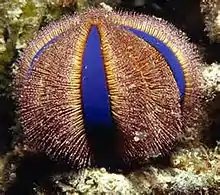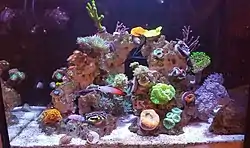Mespilia globulus
Mespilia globulus, commonly known as the globular or sphere sea urchin or by its commercially used name, the tuxedo urchin, is a member of the phylum Echinodermata, which includes starfish, sea cucumbers, sea urchins, and sand dollars.[1] Globulus is Latin for a small ball/spherule, describing their overall shape/morphology.[1] The diameter of their test can be up to 5 cm, and have relatively small spines or quills, reaching lengths up to 2 centimeters. They can be recognized by radial symmetry and their relatively small spines covering them, usually brown, red or dark in color.[2] They can be characterized by ten vertical zones that are not covered in spines which are distinct due to their vibrant shades of blue/green and can be described as having the texture of velvet.[3]
| Mespilia globulus | |
|---|---|
 | |
| Mespilia globulus. Note the radial symmetry and the presence and distribution of the spines | |
| Scientific classification | |
| Kingdom: | Animalia |
| Phylum: | Echinodermata |
| Class: | Echinoidea |
| Order: | Camarodonta |
| Family: | Temnopleuridae |
| Genus: | Mespilia |
| Species: | M. globulus |
| Binomial name | |
| Mespilia globulus (Linnaeus, 1758) | |
Distribution and habitat

They mainly inhabit shallow water reefs, coral rubble, and seagrass bed environments, generally at depths of 0–200 meters.[4] They occur in shallow, tropical waters in the Indo-Pacific and Indian Ocean as well as the south west coast of the western Pacific and Japan.[4] However, they are not constrained to this area, and can be found in most tropical environments near the equator, especially coral reef and seagrass bed environments.[5] During the breeding season, Mespilia globulus can be found abundantly near the coast, but are not as common there other times of the year as they migrate slightly off the coast when not breeding.[5]
Behaviors
Sea urchins feed in coral reef systems, seagrass beds, and fields of coral rubble by 'grazing', eating organic material that has settled or is growing on structure or on the sea floor, while exhibiting nocturnal foraging behaviors. They remain hidden in the coral structure or rocks present in habitat during the day.[5] Recent studies have shown that the presence of 'grazing' feeders, such as Mespilia globulus, significantly increases the survival and growth size of the corals. However, increased Mespilia globulus density has a negative effect on urchin growth as a result of limited food availability.[6]
This species has also been observed to agglutinate debris from its environment in an attempt to camouflage or protect itself. In the pet industry, M. globulus are said to be stressed or sick if they are not carrying any debris on their test.[7] M. globulus has also been observed living in symbiosis with other marine invertebrates, such as crabs, and can be parasitized by some gastropods.[8]
Commercial use

Mespilia globulus are commonly harvested and bred to be sold commercially as they are popular organisms to be put in recreational aquariums due to their vibrant colors and interesting morphology. They are popular for recreational aquariums as they are low-maintenance, and generally do not harm other organisms present. Currently, the pet industry relies on wild-caught M. globulus , as there are only several reports of successfully breeding them in captivity.[7]
Reproduction and life cycle
Reproduction
Mespilia globulus are members of the class Echinoidea, meaning they are gonochoric or have separate sexes, male and female. Breeding season is typically from July to September in the Pacific and Indian Oceans.[9] Fertilization is often external and brooding is also common, where the eggs are held either on the peristome or deep into the concavities on the petaloid.[10] Clouds of sperm and eggs are released by the organisms and fertilization occurs in the water column. It is expected that in the future ocean acidification will threaten the sea urchins current process of reproduction.[11]
Sea urchin life cycle
Eggs are fertilized in the water column and rapidly develop into swimming larvae.[6] These larvae migrate to the surface waters where they feed until further development. After several weeks, the rudiment, which will give way to the adult sea urchin, develops. During the development of the rudiment, adult features, such as tube-feet ,appear and larval features disappear. The metamorphosed juvenile then sinks to the sea floor to begin its adult benthic lifestyle.[12]
References
- "WoRMS - World Register of Marine Species - Mespilia globulus (Linnaeus, 1758)". www.marinespecies.org. Retrieved 2022-04-12.
- Bell, F. J. On some genera and species of the Temnopleuridæ. London: Zoological Society of London.
- "Mespilia globulus (Oursin grimpeur)". AquaPortail (in French). Retrieved 2022-04-12.
- "Digimorph - Mespilia globulus (globe urchin)". digimorph.org. Retrieved 2022-03-14.
- Waren, Anders (December 1980). "Descriptions of New Taxa of Eulimidae (Mollusca, Prosobranchia), with Notes on Some Previously Described Genera". Zoologica Scripta. 9 (1–4): 283–306. doi:10.1111/j.1463-6409.1980.tb00668.x. ISSN 0300-3256. S2CID 85007760.
- Craggs, Jamie; Guest, James; Bulling, Mark; Sweet, Michael (2019-09-10). "Ex situ co culturing of the sea urchin, Mespilia globulus and the coral Acropora millepora enhances early post-settlement survivorship". Scientific Reports. 9 (1): 12984. Bibcode:2019NatSR...912984C. doi:10.1038/s41598-019-49447-9. ISSN 2045-2322. PMC 6737180. PMID 31506526.
- Michael (2021-11-25). "Tuxedo Urchin Urchin – Detailed Guide: Care, Diet, and Breeding". Shrimp and Snail Breeder. Retrieved 2022-04-12.
- "Mespilia globulus (Tuxedo Urchin)". Reef App. Retrieved 2022-04-12.
- Kobayashi, Naomasa (1967-01-25). "Spawning Periodicity of Sea Urchins at Seto -I. Mespilia Globulus-". Publications of the Seto Marine Biological Laboratory. 14 (5): 403–414. doi:10.5134/175449. ISSN 0037-2870.
- Kasahara, Mami; et al. (November 16, 2012). "Morphogenesis of Adult Traits during the Early Development of Mespilia globulus Linnaeus, 1758 (Echinodermata: Echinoidea)" (PDF). Zoological Studies. 51 (8): 1481–1489.
- Smith, Kathryn E.; Byrne, Maria; Deaker, Dione; Hird, Cameron M.; Nielson, Clara; Wilson-McNeal, Alice; Lewis, Ceri (2019-07-24). "Sea urchin reproductive performance in a changing ocean: poor males improve while good males worsen in response to ocean acidification". Proceedings of the Royal Society B: Biological Sciences. 286 (1907): 20190785. doi:10.1098/rspb.2019.0785. PMC 6661356. PMID 31337311.
- "The Echinoid Directory - Natural History Museum". www.nhm.ac.uk. Retrieved 2022-04-12.